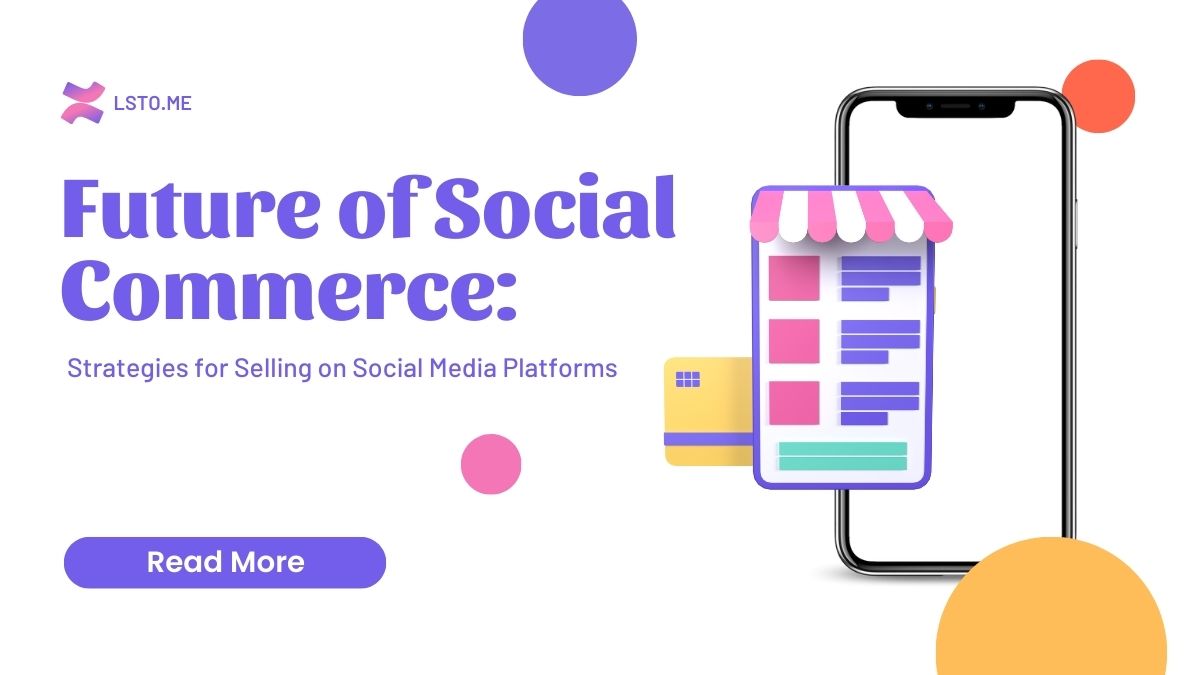
Social media platforms have revolutionized the way people connect and engage online, and they are increasingly becoming key channels for e-commerce. Social commerce is the integration of social media and online shopping, enabling businesses to sell directly to consumers through these platforms. As social media continues to evolve, businesses need to stay ahead of the curve and leverage effective strategies for selling on social media. In this blog post, we will explore the future of social commerce and provide actionable strategies to maximize your success in this dynamic landscape.
1. Embrace Shoppable Posts and Product Tags:
Shoppable posts and product tags are transforming the way we shop online. They provide users with a seamless shopping experience by allowing them to purchase products directly from social media platforms like Instagram, Facebook, and Pinterest. This trend is known as social commerce, and it’s quickly gaining popularity among retailers and consumers alike.
One of the key benefits of shoppable posts and product tags is that they simplify the buying process for customers. Instead of having to navigate through multiple websites or apps to find what they’re looking for, users can simply click on a product tag within a post and be directed straight to the checkout page. This convenience factor has proven to be a game-changer for many retailers who are now seeing increased sales due to this streamlined process.
Another advantage is that shoppable posts and product tags allow brands to showcase their products organically without being too pushy or sales-focused.
2. Utilize Live Shopping:
Live shopping is a new e-commerce trend that involves live streaming of product demonstrations and promotions. It offers customers the chance to ask questions, see products in action, and make purchases in real time. This concept is gaining popularity as it combines the benefits of online shopping with an interactive experience that feels like shopping in a brick-and-mortar store.
The rise of social media has enabled live shopping to become more accessible and easier to implement for businesses of all sizes. Platforms like Instagram, Facebook, and TikTok have added features that support live-streaming commerce, making it easier for sellers to reach potential customers directly. Social commerce has become a buzzword as brands are looking for ways to create more engaging experiences on social networks while driving sales conversions.
3. Leverage Influencer Partnerships:
In today’s digital world, social media has become an integral part of our lives. As a result, influencer marketing has emerged as one of the most effective ways to drive engagement and sales. By collaborating with influencers, businesses can leverage their reach and credibility to promote their products or services.
The rise of social commerce has further increased the importance of influencer partnerships. With more consumers turning to social media for shopping inspiration and recommendations, influencers have become trusted sources for product reviews and recommendations. By partnering with influencers who align with their brand values, businesses can tap into this trend and create authentic connections with their target audience.
However, it is important to approach influencer partnerships strategically. Businesses should carefully select influencers based on factors such as audience demographics, engagement rates, and alignment with brand values. They should also establish clear goals and metrics for measuring the success of influencer campaigns.
4. Invest in Social Listening and Customer Engagement:
Social commerce is a rapidly growing industry that has revolutionized the way businesses interact with their customers. Social media platforms have become an essential tool for companies to engage with their audiences and stay up-to-date on the latest trends, preferences, and sentiments of their consumers. The key to success in social commerce lies in investing in social listening and customer engagement.
Social listening involves monitoring conversations about your brand, products, or services on various social media platforms. By analyzing these conversations, you can better understand your audience’s needs and preferences, identify potential issues before they escalate into crises, and measure the impact of your marketing campaigns. This data can help you make informed business decisions that cater to your customer’s demands.
Customer engagement is equally important as it fosters stronger relationships between businesses and customers. Engaging with your customers on social media helps build trust and loyalty by providing personalized experiences that meet their individual needs.
5. Optimize for Mobile Shopping:
Mobile devices have become an integral part of our daily lives. We use them for everything from communicating with others to browsing social media and shopping online. As mobile usage continues to dominate, optimizing your social commerce strategy for mobile devices is paramount. Today’s consumers are more likely to use their smartphones to make purchases than ever before, and businesses that fail to optimize for mobile shopping risk losing out on sales.
One key component of optimizing your social commerce strategy for mobile devices is ensuring that your website is responsive and easy to navigate on smaller screens. This means designing a layout that is optimized for smaller screens, with large buttons and clear calls-to-action (CTAs) that are easy to tap. Additionally, you should consider implementing one-click checkout options such as Apple Pay or Google Wallet, which can significantly reduce cart abandonment rates among mobile shoppers.
6. Explore Augmented Reality (AR) and Virtual Try-On:
Augmented Reality and Virtual Try-On are two of the most exciting technologies that have revolutionized online shopping in recent years. With these cutting-edge technologies, customers can now try on clothes and accessories virtually or visualize how furniture would look in their room before they make a purchase. Brands that incorporate AR and Virtual Try-On into their e-commerce platforms not only provide an engaging experience for shoppers but also drive conversions.
The rise of social commerce has further accelerated the adoption of AR and Virtual Try-On as more people shop online from social media sites like Instagram and Facebook. Social commerce is all about leveraging social media platforms to sell products directly to consumers, creating an immersive shopping experience through visual storytelling, user-generated content, product reviews, recommendations, etc.
7. Leverage User-Generated Content (UGC):
Social commerce has become one of the most important aspects of modern e-commerce. Social media platforms are now essential tools for businesses to reach potential customers, build brand awareness and loyalty, and generate sales. One of the key elements in social commerce is user-generated content (UGC). UGC includes any type of content that users create and share on social media platforms, such as photos, videos, reviews, comments, and testimonials.
One of the biggest advantages of UGC is that it provides authentic social proof. Consumers are more likely to trust recommendations from their peers than from brands themselves. By leveraging UGC in your marketing efforts, you can showcase how real people use and love your products or services. This not only helps build trust with potential customers but also creates a sense of community around your brand.
8. Implement Social Ads and Retargeting:
Social commerce has become a buzzword in recent years, as businesses are increasingly turning to social media platforms to drive sales. One of the key ways to boost your social commerce efforts is by implementing social ads and retargeting campaigns. Social media platforms offer robust advertising options that allow you to target specific audiences based on their interests, demographics, behaviors, and more.
With social ads, you can create highly targeted campaigns that reach people who are most likely to be interested in what you have to offer. For instance, Facebook Ads enables you to reach people based on their age, gender, location, interests, job titles, and past behavior on your website or app. You can also use Instagram Ads to showcase your products or services through visually appealing images and videos that resonate with your target audience.
Retargeting is another effective strategy for boosting social commerce.
Conclusion:
The future of social commerce holds immense potential for businesses to connect with their target audience, drive sales, and create meaningful customer experiences. By embracing shoppable posts, live shopping, influencer partnerships, social listening, mobile optimization, AR, UGC, and targeted advertising, you can position your brand at the forefront of social commerce and thrive in this ever-evolving landscape. Stay agile, experiment with new features and technologies, and continuously adapt your strategies to leverage the full potential of social media platforms for selling your products.





One Comment